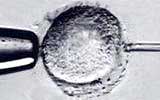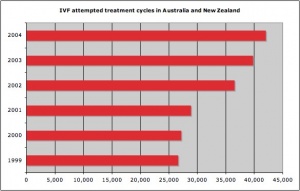2011 Lab 1 - Fertilization
| 2011 Lab 1: Introduction | Gametogenesis | Oogenesis | Spermatogenesis | Fertilization | Online Assessment |
Introduction
Fertilization is a complex interaction between the two haploid gametes (oocyte and spermatozoa) resulting in a single diploid cell (zygote). Following entry of the spermatazoa into the oocyte a series of changes occur within the oocyte and zona pellucida that block further fertilization by additional bound spermatozoa (polyspermy).
Due to both scientific and medical research on this process, this can now occur outside the body (in vitro fertilization) as well as fertility therapies to aid normal (in vivo fertilization). In addition, our understanding of fertilization has led to the development of a number of alternative fertility control methods.
Fertilization Dynamics
Sperm Events
- Capacitation - removal of glycoprotein coat and seminal proteins, alteration of sperm mitochondria
- Binding - ZP3 acts as receptor for sperm
- Acrosome reaction - exyocytosis of acrosome contents (Calcium ion mediated), enzymes to digest the zona pellucida, exposes sperm surface proteins to bind ZP2
- Membrane fusion - between sperm and egg, allows sperm nuclei passage into egg cytoplasm
Egg Events
- Sperm membrane fusion - causes depolarization of egg membrane, in non-mammalian species a primary block to polyspermy.
- Cortical reaction - IP3 pathway elevates intracellular Calcium, exocytosis of cortical granules, enzyme alters ZP3 so it will no longer bind sperm plasma membrane (cortical reaction)
- Second meiotic division - completion of 2nd meiotic division, forms second polar body
Sperm Penetration
Pronuclear Fusion
| In the mouse zygote, separation of chromatin according to parental origin is preserved up to the four-cell embryo stage and then gradually disappears. |
Fertilization Overview
Capacitation
- The mammalian spermatozoa once released, must remain for a time in the female genital tract before having the capacity to fertilize the oocyte. This process involves modifying the spermatozoa.
Acrosome Reaction
- Penetration of egg by spermatozoa is initiated by the acrosome reaction which takes different forms in different species.
- Mammalian acrosomal lysins contain proteinases which lyse the glycoproteins of the zona pellucida.
- The central part of the acrosome elongates into a tube which extends form the head of the spermatozoon. On contact with the egg the acrosomal membrane fuses with the sperm plasma membrane thus opening the acrosomal vesicle and liberating the granules containing acrosomal lysins.
- The inner portion of the acrosomal membrane everts and lengthens to form the acrosomal tubule through which the sperm nucleus enters the egg.
Sperm Contact
The act of fertilization changes the egg from a stage of slow structural and metabolic decline to one of renewed activation. Morphologically egg activation is a series of surface changes immediately following sperm contact.
- Mammals - No phenomenon comparable to the raising of the fertilization membrane is displayed. Mammalian eggs are surrounded by the zona pellucida which undergoes a structural change known as the zonal reaction after sperm penetration. On sperm contact with the egg plasma membrane, cortical granules break down as in above forms, substances liberated into the perivitelline space rapidly modify the zona pellucida resulting in a block to further sperm penetration.
Sperm Activation of Egg
- During fertilization sperm activates the egg by induction of a calcium ion (Ca2+) oscillation within the egg's cytoplasm.
- Induction occurs by a sperm protein factor (unidentified) which can stimulate only once calcium ion oscillations in metaphase eggs.
- Another sperm derived factor is then responsible for the inactivation of this oscillation.
- The activation of the egg by this calcium ion oscillation is essential for entry of the egg into the first mitotic cycle.
- Links: Fertilization
Assisted Reproduction Technology
Assisted Reproduction Technology (ART) is also sometimes also used to identify In vitro fertilization (IVF) but now includes many new techniques.
2008
- Australia - 2008 292,156 women gave birth to 296,925 babies
- 3.2% women received ART treatment
- ranging from 1.4% in the Australian Capital Territory to 3.7% in Tasmania
- 34.1 years was the average age of women who received ART
- 62.7% of mothers who received ART treatment were having their first baby and 37.3% had given birth previously
2005
- 51,017 treatment cycles reported to ANZARD in Australia and New Zealand in 2005.
- 91.1% were from Australian and 8.9% from New Zealand fertility centres
- an increase of 13.7% of ART treatment cycles from 2004.
- 35.5 years average age of women (35.2 years in 2002).
- Women aged older than 40 years has increased from 14.3% in 2002 to 15.3% in 2005.
Single Embryo Transfers (SET)
- Significant increase in the number of SET embryos transfer cycles (2002 28.4%, 2005 48.3%)
- increase of SET cycles resulted more singleton deliveries (singleton deliveries 2005 was 85.9%)
- single-embryo transfer babies had better outcomes compared to babies born to women who had a double-embryo transfer (DET).
- 2005 3,681 SET babies and 5,589 DET babies.
- Singletons babies - 96.1% SET, 61.6% DET
- Preterm babies - 11.7% SET, 30.6% DET
- Low birthweight liveborn babies - 8.0% SET, 25.0% DET
ART Perinatal Mortality Rate
- perinatal mortality rate was 14.7 deaths per 1,000 births (2005)
- 23.8% decrease from 19.3 deaths per 1,000 births in 2004
- Perinatal mortality rate was the lowest among singletons born following SET (7.3 deaths per 1,000 births) in 2005.
Reference: AIHW National Perinatal Statistics Unit Assisted Reproduction Technology in Australia and New Zealand 2005
- Links: In Vitro Fertilization
| 2011 Lab 1: Introduction | Gametogenesis | Oogenesis | Spermatogenesis | Fertilization | Online Assessment |
Glossary Links
- Glossary: A | B | C | D | E | F | G | H | I | J | K | L | M | N | O | P | Q | R | S | T | U | V | W | X | Y | Z | Numbers | Symbols | Term Link
Cite this page: Hill, M.A. (2024, April 27) Embryology 2011 Lab 1 - Fertilization. Retrieved from https://embryology.med.unsw.edu.au/embryology/index.php/2011_Lab_1_-_Fertilization
- © Dr Mark Hill 2024, UNSW Embryology ISBN: 978 0 7334 2609 4 - UNSW CRICOS Provider Code No. 00098G


